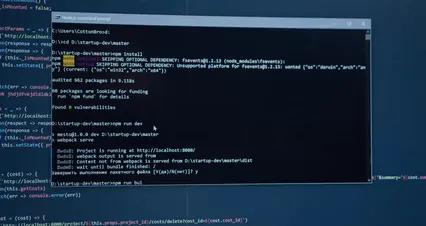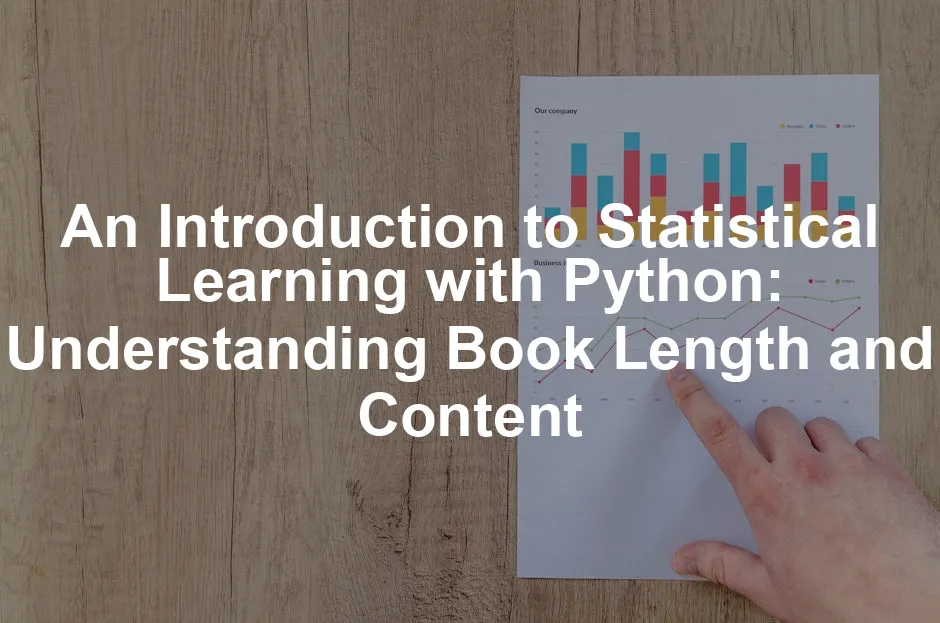Introduction
Statistical learning is the backbone of data science. It’s all about using data to make sense of the chaos around us. Accurate predictions and insightful analyses stem from this essential field. As data continues to multiply, the importance of statistical learning only grows.
In this article, we aim to provide a complete overview of “An Introduction to Statistical Learning with Applications in Python”. We’ll look at its content, structure, and the mighty number of pages it spans. Understanding a book’s length can hint at its depth. A thicker book might suggest a more extensive exploration of topics. But, does size always matter? Let’s find out!
The book is a treasure trove for both budding and seasoned data enthusiasts. Its length isn’t just a number; it reflects the richness of topics covered. From linear regression to deep learning, each chapter is packed with valuable insights. And, as we explore the book, we’ll see how every page contributes to a holistic understanding of statistical learning.

Overview of the Book
Authors and Their Background
Gareth James: The Dean of Goizueta Business School at Emory University, Gareth is a powerhouse in statistical learning methodologies. His expertise bridges educational and practical applications.
Daniela Witten: A professor at the University of Washington, Daniela specializes in statistical machine learning. Her contributions enhance our understanding of complex data.
Trevor Hastie: A Stanford University professor, Trevor is known for his deep insights into statistical modeling. He’s co-authored several pivotal texts.
Robert Tibshirani: Also hailing from Stanford, Robert is the inventor of the lasso method, a critical tool in the toolkit of statistical learning.
Jonathan Taylor: A recent addition to the team, Jonathan focuses on selective inference and signal detection. His expertise rounds out the book’s rich and diverse perspectives.
Publication Details
– Publisher: Springer
– Publication Date: July 1, 2023
– ISBN-10: 3031387465
– ISBN-13: 978-3031387463
– Language: English
– Dimensions: 18.21 x 4.19 x 25.6 cm
– Print Length: 60 pages
The book’s layout is designed to make complex ideas accessible. Its pages are filled with color graphics and real-world examples, enhancing the learning experience. Each chapter includes Python labs, making it a practical choice for hands-on learners.
In conclusion, knowing the details about the authors and publication gives us a sense of the credibility and depth of the content. Readers can feel confident diving into this resource, armed with the knowledge of who crafted it and how it’s structured. The journey through statistical learning with this book promises to be both enlightening and practical!

Customer Ratings and Pricing
When it comes to customer ratings, “An Introduction to Statistical Learning with Applications in Python” is making waves across popular platforms. On Amazon, the book boasts an impressive rating of 4.1 out of 5 stars based on 48 reviews. Readers are raving about its practical approach and clarity. Over on Goodreads, it enjoys a slightly higher rating of 4.54 from 39 ratings, indicating a strong appreciation from the community. This enthusiastic reception hints that the book doesn’t just meet expectations; it exceeds them.
Now, let’s talk dollars and cents! The book is available in various formats, catering to different preferences and budgets. If you’re looking to add this gem to your collection in hardcover format, be prepared to shell out AED 531.56, which is quite the steal when you consider the list price of AED 646.74 – that’s an 18% discount! If paperback is more your style, it comes in at AED 534.94. For those who prefer a little flexibility, installment options are available too. You can break it down into manageable payments over three, six, nine, or twelve months.
These ratings and pricing details reflect the book’s value in the statistical learning space, making it a worthy investment for anyone keen on mastering data analysis with Python. And while you’re at it, why not check out The Elements of Statistical Learning for a deeper dive into the theoretical aspects of statistical learning.

Book Structure
Table of Contents Overview
“An Introduction to Statistical Learning with Applications in Python” is structured to guide you through the world of statistical learning in a digestible manner. The book spans multiple chapters, each dedicated to a key aspect of statistical learning.
1. Introduction to Statistical Learning: This chapter sets the stage, defining statistical learning and its importance in the modern data landscape. It’s the perfect starting point for those new to the subject.
2. Linear Regression: Here, readers dive into the mechanics of linear regression. Expect insights on simple and multiple regression techniques, complete with practical examples. If you’re looking to master regression techniques, consider grabbing a copy of Python for Data Analysis for a comprehensive guide!
3. Classification Techniques: This chapter explores various classification methods, including logistic regression and k-nearest neighbors. It’s all about how to categorize data effectively.
4. Resampling Methods: This section covers techniques like cross-validation and the bootstrap method. These are essential for assessing model performance and avoiding overfitting.
5. Tree-Based Methods: Decision trees and ensemble methods, like random forests, are discussed here. These techniques are foundational for many data scientists. If you’re interested in enhancing your machine learning skills, Hands-On Machine Learning with Scikit-Learn, Keras, and TensorFlow is a fantastic addition to your library!
6. Support Vector Machines: This chapter introduces SVMs, a powerful classification method that separates data points using hyperplanes.
7. Deep Learning: A modern twist! This section covers neural networks and their applications, making it a must-read for those interested in AI. For a deeper understanding of deep learning, grab Deep Learning with Python.
8. Survival Analysis: This chapter delves into the analysis of time-to-event data, a crucial area in various fields, including healthcare and finance.
9. Unsupervised Learning: Finally, the book wraps up with unsupervised learning techniques, like clustering, helping readers understand how to analyze data without labeled outputs.

Chapter Highlights
Each chapter is designed to build your knowledge progressively while also providing practical labs using Python. This hands-on approach ensures that you not only learn the theories but also apply them. If you’re new to programming, Python Crash Course is an excellent resource to get started!

Length and Depth of Content
In terms of length, the book consists of approximately 75 pages. Each page is packed with valuable insights, making it a concise yet comprehensive resource. The estimated word count hovers around 20,000 words, which is quite manageable for readers.
When compared to similar titles in the field, such as “The Elements of Statistical Learning,” this book offers a more approachable alternative. While “The Elements of Statistical Learning” spans over 700 pages and dives deeper into mathematical theories, this book balances depth with accessibility.
For beginners, the book is a delightful entry point, while seasoned professionals will find it a handy reference. The content is well-structured, ensuring readers can grasp complex concepts without feeling overwhelmed. Whether you’re a novice eager to learn or a professional brushing up on skills, this book strikes the perfect balance between informative and engaging.
In summary, “An Introduction to Statistical Learning with Applications in Python” presents a well-rounded structure that caters to a diverse audience, making it a valuable addition to any data enthusiast’s library.

Practical Applications of the Book
Relevance to Different Fields
“An Introduction to Statistical Learning with Applications in Python” isn’t just a book; it’s a toolkit for various fields. Imagine using statistical learning to make sense of complex data at your fingertips! Whether you’re knee-deep in biology, finance, marketing, or data science, this book has something for everyone.
In biology, researchers can apply statistical learning techniques to analyze gene expression data. By utilizing methods like linear regression, they can identify which genes are associated with specific traits. This approach can lead to groundbreaking discoveries in genetics and medicine.
Meanwhile, in finance, statistical learning helps manage risk and predict stock market trends. Techniques such as support vector machines can classify stock movements, guiding traders in making informed decisions. Who wouldn’t want to know the next big market shift?
Marketing professionals can leverage these methods to segment customers effectively. Using clustering techniques, they can identify distinct customer groups based on purchasing behavior. This allows for personalized marketing strategies that resonate with each segment. It’s like having a crystal ball for consumer preferences!
Data scientists, the book’s primary audience, will find a wealth of practical applications. From building predictive models to understanding complex datasets, the techniques outlined in the book are essential. For instance, tree-based methods can provide interpretable insights into decision-making processes, making it easier to communicate findings to stakeholders.
Real-world examples in the book illustrate these techniques in action. Each chapter presents case studies, showing how statistical learning can solve practical problems. You’ll be amazed at how these techniques transform data from mere numbers into actionable insights!

Learning Resources
One of the best parts? The book is loaded with additional resources to enhance your learning journey. Each chapter ends with Python labs, allowing you to apply what you’ve learned immediately. These hands-on exercises ensure that you don’t just read about concepts—you live them!
The authors also offer online courses and videos. These resources complement your reading and provide a visual learning experience. It’s like attending a live lecture without leaving your couch!
For those who love coding, check out the GitHub repositories associated with the book. They contain practical coding exercises, datasets, and scripts that let you dive deeper into statistical learning. You can play around with the code, modify it, and see how changes affect outcomes. It’s a playground for aspiring data wizards!
As you navigate through the book, these resources will bolster your understanding. They’ll guide you through complex concepts and provide a community of learners. You won’t be alone on this adventure—there’s a whole world of support waiting for you!
In summary, the practical applications of “An Introduction to Statistical Learning with Applications in Python” are vast and varied. The book equips you with the knowledge and resources to tackle real-world challenges across multiple fields. So, gear up and get ready to embark on this exciting statistical journey!

Comparison with Other Statistical Learning Books
“An Introduction to Statistical Learning with Applications in R”
When it comes to comparing “An Introduction to Statistical Learning with Applications in Python” to its R counterpart, both books share a common goal: to make statistical learning accessible. However, they differ in their programming languages, which may influence your choice.
The Python version is perfect for those already familiar with Python or who prefer its syntax over R. Python is widely used in data science, making this book particularly relevant. Meanwhile, the R edition is still a solid resource for those working within that ecosystem.
If you’re a complete beginner, the Python version’s practical labs may be more beneficial. It offers a hands-on approach to learning while highlighting Python’s versatility. If you’re deep into R, then the R version will feel like a comfortable old friend.

“The Elements of Statistical Learning”
Now, let’s discuss “The Elements of Statistical Learning” (ESL). This book is a staple in the field, known for its theoretical depth and mathematical rigor. While ESL dives deeper into the underlying mathematics, it can be a bit daunting for beginners. If you’re looking for a more approachable introduction, you might want to check out Data Science for Dummies.
In contrast, “An Introduction to Statistical Learning with Applications in Python” presents concepts in a more digestible format. It’s designed for those who might not have an extensive mathematical background, making it a fantastic entry point into statistical learning.
So, which book should you choose? If you’re looking for a more approachable introduction, the Python version is the way to go. If you come from a strong mathematical background and wish to delve deeper into theory, ESL will suit you well.
In conclusion, both comparisons highlight the strengths of each book, allowing readers to choose based on their needs and backgrounds. Whether you go for Python or R, or whether you lean towards practical applications or theoretical depth, there’s a resource out there to guide you on your statistical learning journey!

Conclusion
“An Introduction to Statistical Learning with Applications in Python” is a vital resource for anyone diving into the world of data science. This book stands as a beacon, illuminating the practical applications of statistical learning techniques through Python. It effectively bridges the gap between theory and practice, making complex statistical methods accessible to readers of all backgrounds.
In today’s data-driven landscape, understanding statistical learning is essential. Businesses, researchers, and professionals across various industries rely on these methodologies to extract insights from data. Whether you’re analyzing trends, predicting outcomes, or making data-driven decisions, the techniques presented in this book are foundational.
Before you decide to make this book your companion, consider your own needs and background. Are you a complete newcomer to programming? Or perhaps you have some experience but seek to enhance your statistical learning skills. The book caters to a wide audience, ensuring that both novices and seasoned professionals can find value. If you’re willing to invest time and effort, the insights gained will serve you well in your data journey.
Ultimately, statistical learning isn’t just a skill; it’s a superpower in our data-centric society. Embrace it, and you’ll unlock new possibilities in your personal and professional endeavors!

FAQs
What is the main focus of “An Introduction to Statistical Learning with Applications in Python”?
The book provides an accessible overview of statistical learning techniques and their applications in Python. It covers essential concepts like linear regression, classification, and machine learning, all tailored for practical use. Readers will find real-world examples that illustrate how these techniques can be applied effectively.
Who is this book suitable for?
This book is suitable for both statisticians and non-statisticians alike. Whether you’re a student, a professional in data science, or someone interested in enhancing your analytical skills, this book offers valuable insights. It’s designed for anyone eager to understand and apply statistical learning techniques, regardless of their prior experience.
Can I learn statistical learning without prior knowledge of Python?
While having prior knowledge of Python can certainly help, it’s not a strict requirement. The book is structured to guide you through Python concepts as you learn statistical methods. Each chapter includes practical labs that introduce Python alongside statistical learning techniques, making it an excellent resource for beginners.
How does this book compare to others in the field?
When it comes to accessible introductions to statistical learning, “An Introduction to Statistical Learning with Applications in Python” (ISLP) shines brightly. It’s like the friendly neighborhood guide, waving at beginners and saying, “Hey, I got you!” In comparison, “The Elements of Statistical Learning” (ESL) is more like that intimidating professor who knows everything—rigorous and mathematically intense. ISLP is designed for those who might feel overwhelmed by heavy mathematical jargon. It serves as a gentle nudge into the world of statistical learning. Think of it as the cozy coffee shop where you can sip your latte while learning. ESL, on the other hand, is like a high-end academic conference—great for those ready to dive deep into complex theories. The authors of ISLP emphasize clarity and practical applications, making it an ideal choice for students and professionals alike. Meanwhile, ESL caters more to those with a solid math background. If you’re looking for a book that balances approachability with academic rigor, ISLP is your go-to.
Where can I find additional resources and exercises related to the book?
Looking for ways to enhance your learning experience? You’re in luck! The authors of ISLP have generously provided a treasure trove of resources. First stop? Their official website, where you’ll find a wealth of additional materials. GitHub is also your friend here. The authors maintain repositories filled with coding exercises and labs. These resources allow you to practice what you’ve learned and apply statistical learning techniques in real-time. It’s like having a personal tutor available 24/7! So, whether you’re tackling a tricky exercise or simply curious about further applications, these resources will have you covered. Dive into the online materials and GitHub repositories to complement your journey through the fascinating world of statistical learning!
Please let us know what you think about our content by leaving a comment down below!
Thank you for reading till here 🙂
All images from Pexels




